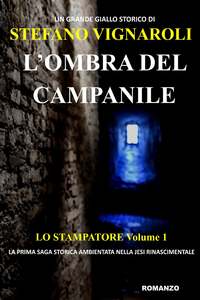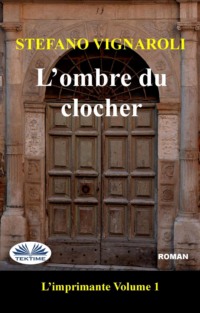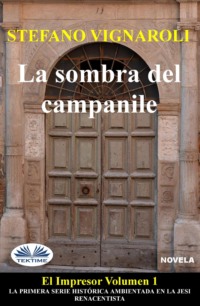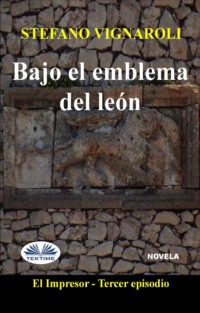
Полная версия
The Shadow Of The Bell Tower
«You have many beautiful ideas, you’re young and full of enthusiasm, and I understand you, but most of the access to the basement is forbidden, as you have to pass through the cellars of private buildings, whose owners most often deny consent.»
The old dean was peering at the girl with his green eyes from behind the lenses of the glasses. The grey beard could not conceal the sense of disapproval he felt towards the electronic cigarette, from which Lucia occasionally sucked a cloud of thick, whitish vapour, which in a matter of moments vanished into the air of the room.
«There is no need for physical exploration of the basement. A helicopter could fly over the city to get radar readings. This is the technique now and it gives excellent results», Lucia tried to insist, to see one of her greatest dreams come true.
«I wonder how much money would be needed for such a project. We have funds, but they’re quite limited. Italy has not yet come out of the economic crisis that has been afflicting it for several years now, and you come to me to propose pharaonic projects? Culture is beautiful, I am the first to say so, but we must keep our feet on the ground. See what you can achieve by exploring the basement of this building. They communicate directly with the crypt of the Cathedral, you could come up with something interesting. But do it outside the hours you’re paid for. Your task here is well defined: reorganize the library!» The Dean was about to leave the girl to her work, and to her disappointment, when he turned around and said, «And, one last thing! Electronic or not, there’s no smoking in here. I would ask you not to use that thing while you’re working.»
With a dramatic gesture, Lucia pulled the electronic cigarette out of its neck with the cord, turned off the switch and put it in its case, which she slipped into the bag. From the same bag she took a pack of cigarettes and a lighter and gained the entrance hall to go and smoke a real cigarette outside.
Tuesday, May 30, 2017, from the early hours of the morning, it was a clear, late spring day. The sky was blue and, although the sun was still low, Lucia was dazzled by the light as soon as she closed the front door behind her. She had found an excellent accommodation, renting a renovated apartment in Via Pergolesi, in the historic centre, a few hundred meters from her place of work. But the more interesting thing was the fact that she was right in the building that had housed, on the ground floor, in the 16th century, one of the first printing works in Jesi, that of Manuzi. The huge hall used as a printing house had been used for other purposes over time, even as a gym and as a meeting room for some political parties. But this did not take away the charm of the place. Leaving the main door and passing through a small courtyard, Lucia used to stand back and admire the arch from which one could go out onto the ancient paved road, Via Pergolesi, once the Cardo Massimo of Roman times, later called Via delle Botteghe or Via degli Orefici, for the pre-eminent activities that had taken place there during the various periods. Of the splendid shops of the past, in fact, very few remained. Many of them had shutters that had been lowered for several years, and the open ones showed off goods and services that had little to do with antiquity, with the pomp and splendour of the goldsmiths’ shops of the past. The tourist sign smeared with pigeon shit indicated that the arch of the Verroni’s Palace was not of Roman origin, as appearance might lead one to believe, but had been built in the fifteenth century by Giovanni di Gabriele da Como, an architect who had worked alongside the more famous Francesco di Giorgio Martini in the construction of the nearby Palazzo della Signoria. So much so that someone in the past had also attributed that arch to Di Giorgio Martini. According to Lucia, the Romans must not have been completely unrelated to that work, which overlooked the Cardo Massimo. Perhaps the Renaissance architects had limited themselves to restoring an ancient arch, whose remains had survived the centuries and the ruinous earthquake of the year 848.
A few steps between the austere buildings in the historic centre were enough to make Lucia pass from the shady Via Pergolesi to the bright Piazza Federico II. It was still a few minutes to 8:00 a.m., the time when she had to attack to work. She would have had time to smoke another cigarette before entering the Palace, but her attention was drawn to the four marble statues that supported the balcony on the first floor like caryatids. For a moment, she had the impression that the four “telamons” were animated with their own life, as if they wanted to come towards her to talk to her, to tell her centuries-old stories, whose memory had been lost. It was like a dizziness that made her imagine the balcony, no longer supported by the mighty statues, leaning dangerously towards the ground, and brought to mind the dream that had made her the protagonist of a story that had happened exactly five centuries earlier, in those same days of the year and in those places. The images of dreams flowed through her mind during her sleep like scenes from a serial novel. They were so clear that Lucia impersonated herself in her eponymous ancestor as if she was reliving her past life, both as an interpreter and as a spectator.
Suggestion, just suggestion!, she repeated for the umpteenth time the young woman to herself. All because of the books I’m working on and the missing parts of the History of Jesi. My unconscious makes me invent the missing part of the book!
She took two deep breaths, reached a bench, sat down and observed that the facade of the building was there, intact and unharmed. She decided to cross the square, reach the bar and take a strong espresso before going to work. That diversion would have cost her a few minutes’ delay, but the dean never arrived before nine o’clock. She quickly consumed her coffee and left the Bar Duomo, a few steps away she reached the side of the square where Via Pergolesi converged. On her left was the mouth of Via del Fortino, on his right the beginning of the Costa Lombarda, through which she could reach the lower part of the city. Right under his feet, on a large bronze tile was engraved the map of ancient Aesis. A little further on, the inscription in various languages, including Arabic, on the white tiles along the entire perimeter of the square: “On 26 December 1194 Emperor Frederick the Second of Swabia was born in this square”. Still a dizziness, still a vision. Now the square no longer had its present appearance. The lions’ fountain, with the obelisk, no longer stood in the centre, but the space was completely free. The Cathedral, on the opposite side, was a white building, smaller in size than the recent one, in Gothic style, with spires and pointed arches, a sort of small Cathedral of Milan. The bell tower was to the right of the facade, isolated and in an advanced position on the front of the church. The Baldeschi Palace, on the left of the Cathedral, was different, more massive, more sumptuous; the facade was surmounted, as embellishment, by three stone arches, perhaps taken from an ancient Roman construction and put up there in a false way, as a decorative element, but of no use. The statue of the Virgin Mary with the baby Jesus in her arms was already present in a niche between the windows on the top floor, while there was no trace of the four “telamons” supporting the balcony on the first floor. On the contrary, the balcony, although not completely absent, was very small compared to what it was used to seeing. The entire right side of the square was occupied, in place of the Bishop’s Palace and Palazzo Ripanti, by an enormous fortress, a sort of castle, decorated with typical arches and swallow-tailed Ghibelline merlons. On the left side there were the Church of St. Florian, with its dome and bell tower, and the Ghislieri Palace, not yet finished, surrounded by the bricklayers’ scaffoldings. Lucia looked towards the beginning of Via del Fortino, where there was a dyer’s shop, in front of which the craftsman had lit a fire to boil water in a pot encrusted with carbon black. A little girl had approached the fire dangerously and a strip of her dress had caught fire. In short, the girl found herself wrapped in flames. Lucia wanted to run towards to help her, but she couldn’t take a step. She was horrified, hearing the girl’s desperate cries ringing in her ears. Then one, two raindrops, one roar, the flames were extinguished. The feeling of no longer touching his feet on the ground. Lucia was lying on the pavement. When she opened her eyes again she saw the blue sky, a sky from which not a single drop of rain could have fallen. A distinguished man, elegantly dressed, with a briefcase in his hand, tried to help her get up.
«Are you all right?»
«Yes, yes», and refusing any help, Lucia stood up. «It was just a failure, a pressure surge. Everything’s all right now, thank you!»
She crossed the square, which now had the usual appearance, at a good pace, to try to get to her place of work as soon as possible, before the dean could notice her delay, but with the images she had experienced for a few moments well printed in her mind.
Suggestion, only suggestion, nothing but suggestion. There is no other logical explanation for dreams and now for visions!
Yet, a voice from her subconscious seemed to want to tell her that they were memories, that they were episodes she had lived in another life, in a remote past, as a different person, but always bearing the same name: Lucia.
She entered the building, climbed the staircase leading to the first floor and started the computer at her workstation. The temptation to take a peek at her profiles in the various social networks was made vain by the knowledge that the bastard of the dean was punctually checking, through the server, the log file of her computer and reproached her if she allowed herself to surf the Internet for reasons not strictly related to work. So she opened the Excel worksheet where she went to classify the texts and the Access file where she recorded the data in order to have a complete database of the library. Each text was then scanned and stored in a PDF file, to be uploaded to the foundation’s website for later consultation. The texts she was working on in those days, and which had perhaps been the trigger for her dreams and recent visions, were a “History of Jesi” published by Manuzi, the very Bernardino Manuzi who in the sixteenth century had the printing house in the palace where she had taken up residence, and a booklet, whose author was Lucia Baldeschi, entitled “Principles of natural medicine and healing with herbs”.
Then she had on her table a manuscript of a few pages, according to her, also attributable to Lucia Baldeschi, who was trying to describe the meaning and symbolism of a particular seven-pointed pentacle. All three of them were real puzzles, and Lucia would not give up until she had unravelled the arcana that hid behind each of those texts. “The History of Jesi” was really interesting, a work started by Bernardino Manuzi, printer in Jesi, based on ancient documents and oral traditions, and completed thanks to the contribution of other authors. On his table he had an original copy of the book, printed by Manuzi himself, from which several pages had been torn out, who knows in what remote period, who knows by whom, who knows for what reason. Precisely the pages that referred to a painful period in the history of Jesi, from 1517 to 1521, a period marked by the “sack of Jesi” and the government of Cardinal Baldeschi who, thanks to the fact of being head of the Inquisition Tribunal, had persecuted and had executed many people just because they hindered his power. And Lucia Baldeschi was his niece. An inquisitor uncle and a niece who devoted herself to natural medicine and herbal medicine, considered at that time witchcraft practices. How could they live together and perhaps live in the same palace? The fact that Lucia Baldeschi’s writings were there made one lean towards the theory that she had lived there, and certainly that was also the Cardinal’s home. The Court of the Inquisition had its seat right next door. At the beginning of the 16th century, at the Cardinal’s request, it had been transferred from the convent of San Domenico to the more comfortable complex of St. Florian, while the Torrione di Mezzogiorno had remained the seat of the prisons where the condemned were held and tortured. Who knows what those removed pages of the book were about; perhaps there was a scabrous story in which the uncle accused his niece of witchcraft, had locked up her in the dungeons of the Torrione di Mezzogiorno, or in the more comfortable ones of the St. Florian complex, had tortured her and finally had burned her at the stake in the public square. Of course, this story would have tarnished the memory of Cardinal Baldeschi, and so someone in the family would tear out those pages to make them lose track.
It was starting to get hot, and Lucia opened the large window of the room, just the one giving on the balcony supported by the four strange statues, taking care to close the large mosquito net, so that air could enter, but not annoying insects. While the dean appeared, he reproached Lucia with his gaze, an inquisitive gaze, who seemed to want to interpret in the gesture of opening the window the young woman’s contemporary desire to light a cigarette.
I will certainly not give you satisfaction, old caryatid! I certainly don’t smoke here, if only because I can’t stand your mischief, but also out of respect for the precious objects, books, stuccoes, paintings, which are kept in here, Lucia brooded to herself, while she noticed the similarity between the dean, the almost seventy-year-old Guglielmo Tramonti, and Cardinal Artemio Baldeschi, as she saw him every day in a portrait hanging on the walls of the room and as he appeared to her in her recent dreams.
«Even though we don’t have air conditioning here, it’s best to keep the windows closed. Sweating has never hurt anyone, and the air could be harmful to the works we have in custody!» Lucia saw the dean heading towards the window, but instead of closing it as she intended, he opened the mosquito net and looked out through the metal railing on the balcony. In a moment, the dean disappeared. Lucia rushed to the balcony and looked down. Guglielmo Tramonti’s body laid lifeless on the pavement of the square, face down on the ground, dressed as a Cardinal and surrounded by a reddish patch of his own blood. How did it could happen? Where did all that blood come from? The height was not too high! Had he smashed his skull and his vital fluid was leaving him from an open wound on his forehead? And the clothes? Why was he wearing the purple suit? He wasn’t wearing it a few moments before! She looked up looking for the details of the Square and saw it again as it was in the vision she had had just before, when she had left the bar: the Square of a Renaissance city. The voice of the Dean, coming from behind, brought her back to reality. She found herself focusing with his eyes on the tombstone which, on the facade of the Church of St. Florian, remembered Giordano Bruno as a victim of priestly tyranny. Everything was again in its place, the fountain with the obelisk, the Complex of St. Florian, the Cathedral, the Bishop’s Palaces, Palazzo Ghislieri. A little further on, on the bell tower of the Government Palace waved normally the tricolour flag.
«Well? I asked you to close the window and what do you do, you go out on the balcony? But... are you sure you’re okay, girl? You look very pale. Do you want to go home for the day?»
«No, no, thanks, I’m fine. It’s all gone, just a dizzy spell. I instinctively needed to go out for some oxygen, to get some fresh air. But it’s all right now, I can get back to work.»
«Fine, but I’d be glad to know you’re getting a medical check-up. You’re not pregnant, are you?»
«The Holy Spirit hasn’t come to visit me yet», Lucia concluded ironically, accompanying these last words with an evasive gesture of her hand. She took the book on the History of Jesi and began to scan the first pages. On the tenth page, she opened the OCR program on the computer and started to manually correct errors, which allowed her to read some new parts, unknown to her.
THE LEGEND OF A KING
The story of Jesi began on a distant day three thousand years ago. A beginning without spectators. A small crowd of people climbed up the course of our river, stuck along the left bank. They advance slowly, opening the way between the thick brushwood and the tall poplar trees reflecting in the waters of the river.
They are strange people, with a strange name, “pelasgi” they are called, their faces are tanned, marked by the tiredness of a long and adventurous journey. They have worn-out clothes; someone wear skins of animals that smell wild. The faces of men are framed by thick hair and thick beards that endless days of sunshine have made them dry, wicked.
They are the survivors of a flotilla of small and fast boats that won the battle against the storms of the Adriatic sea. They landed a few days ago towards the mouth of that river that now crumbles into a thousand glistening rays of the sun. Emigrated from their land, which was the homeland of their elders, heroes sung by a blind poet for the villages of distant Greece, they are looking for a new land, a new homeland.
And here they are, after an exhausting march, at the foot of a hill that grew as if by magic in the heart of the valley that had welcomed them down, at the mouth of the river. All around, woods as far as the eye can see, climbed on the surrounding hills. And the silence of a nature asleep for millennia. Always.
A man, with a venerable and regal appearance, with the sign of command, points out that promontory that almost looks like a small island emerged at a beautiful position, in the middle of the valley, to collect some castaways. And he walks in that direction. The others follow him, keeping his pace, without speaking. On the highest part of the hill, the old king pushes his gaze away, discovering a marvellous landscape, drawn by the hundred shades of an immense green, barely cut by the sinuous trace of the river that sinks down, towards the sea.
The old king, then turned to his own, nods in agreement and everyone lays their poor things on the ground. So they finally found the promised land, they reached the goal of their long wanderings through seas and lands.
This, from now on, will be their new home.
And so it was that King Esius founded the city of Jesi.
And so the first Jesi’s inhabitants were Greeks, fleeing the destroyed city of Troy. Like Aeneas, who had gone up the coasts of the Tyrrhenian Sea to settle in Latium, King Esius had found the easiest way up the Adriatic Sea and reached the mouth of the Esino river.

Lucia had become enthusiastic about this history, and dreams and visions were now relegated to a remote corner of her mind. Her brain and imagination were already in gear.
This data and news could be used for a good publication or, why not, for the writing of a historical novel set in these areas, Lucia began to think, also meditating on possible gains.
Конец ознакомительного фрагмента.
Текст предоставлен ООО «ЛитРес».
Прочитайте эту книгу целиком, купив полную легальную версию на ЛитРес.
Безопасно оплатить книгу можно банковской картой Visa, MasterCard, Maestro, со счета мобильного телефона, с платежного терминала, в салоне МТС или Связной, через PayPal, WebMoney, Яндекс.Деньги, QIWI Кошелек, бонусными картами или другим удобным Вам способом.











